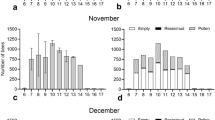Abstract
Different types of biological adhesion can be categorized according to the length scales, structures, and materials involved. The setal adhesion system of the gekkonid lizards occupies a hierarchy of scales from the toes (~ 1 cm) to the terminal spatular pads on the setal branches (~ 100 nm). This unique combination of scale and foot-hair morphology allow the animal robust, controllable, and near-universal adhesion via van der Waals attraction, but it is also apparent that the mechanical behavior of the β-keratin plays an important role in an animal’s climbing ability. Experimental results show a four-fold increase in the viscoelastic loss tangent of β-keratin, alongside a substantial increase in adhesion of setal arrays, over a range of relative humidity from 10 to 80%. A model of single-spatular deformation predicts that the elastic energy stored in the setal branches, energy which is not completely recovered on detachment, is strongly influenced by these properties changes. The enhanced dissipation characteristics of the system explain the effects of environmental humidity on the clinging ability of geckos.
Similar content being viewed by others
References
Autumn, K., et al., J. Exp. Biol. 209: 260–272 (2006).
Russell, A.P., Integr. Comp. Biol. 42: 1154–1163 (2002).
Autumn, K., et al., J. Exp. Biol. 209: 3569–3579 (2006).
Hansen, W.R. and K. Autumn, Proc. Natl. Acad. Sci. USA 102: 385–389 (2005).
Autumn, K., et al., Proc. Natl. Acad. Sci. USA 99: 12252–12256 (2002).
Geim, A.K., et al., Nat. Mater. 2: 461–463 (2003).
Sitti, M. and R.S. Fearing, Proceedings of the 2nd IEEE Conference on Nanotechnology 137–140 (2002).
Bhushan, B., J. Adhes. Sci. Technol. 21: 1213–1258 (2007).
Johnson, K.L., K. Kendall, and A.D. Roberts, Proc. R. Soc. Lond. A 324: 301–313 (1971).
Kendall, K., J. Phys. D: Appl. Phys. 8: 1449–1452 (1975).
Gravish, N., M. Wilikinson, and K. Autumn, J. R. Soc. Interface 5: 339–348 (2008).
Huber, G., et al., Proc. Natl. Acad. Sci. USA 102: 16293–16296 (2005).
Bonser, R.H.C., J. Mater. Sci. Lett. 21: 1563–1564 (2002).
Taylor, A.M., R.H.C. Bonser, and J.W. Farrent, J. Mater. Sci. 39: 939–942 (2004).
Maugis, D. and M. Barquins, J. Phys. D: Appl. Phys. 11: 1989–2023 (1978).
Andrews, E.H., J. Polym. Sci. Pol. Sym. 72: 295–297 (1985).
Saulnier, F., et al., Macromolecules 37: 1067–1075 (2004).
Jagota, A. and S.J. Bennison, Integr. Comp. Biol. 42: 1140–1145 (2002).
Author information
Authors and Affiliations
Rights and permissions
About this article
Cite this article
Puthoff, J.B., Prowse, M., Wilkinson, M.J. et al. Energy Storage, Release, And Dissipation In The Gecko Adhesion System. MRS Online Proceedings Library 1301, 193–197 (2011). https://doi.org/10.1557/opl.2011.574
Published:
Issue Date:
DOI: https://doi.org/10.1557/opl.2011.574




